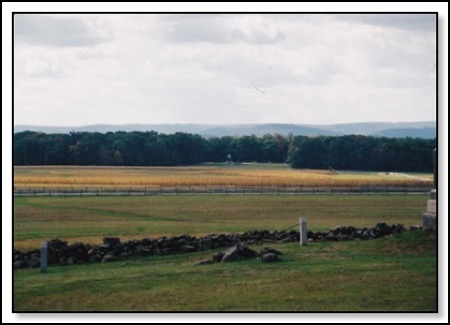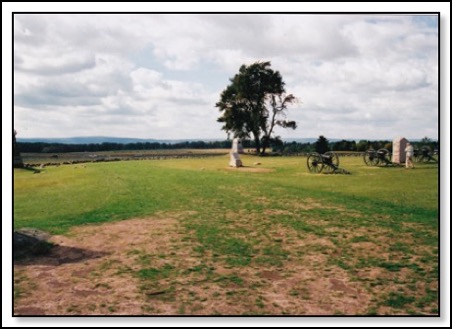Gettysburg at 150, Third Day
03/07/13 16:03 Filed in: History
The last day of the battle………….Pickett’s Charge. One last push that was never enough. Lee gambled and his soldiers paid this day 150 years ago. More than one mile across the fields from Seminary Ridge, the Emmitsburg Road to the stone wall and The Angle. They almost made it, yet the Union held.
Looking toward Seminary Ridge from the stone wall, Pickett’s Charge

Clash of colours and cultures, the high watermark, at The Angle

Gettysburg, Day 3
Throughout the war, Robert E. Lee had always sought a way to “get at those people over there.” His aggressiveness had served the Confederate cause well on many battlefields, but on July 3, 1863, it led to disaster.
Despite the passionate arguments of Longstreet, Lee instructed his “Old War Horse” to strike the Union center on Cemetery Ridge, using the divisions of Brig. Gen. James Johnston Pettigrew, Maj. Gen. Isaac Ridgeway Trimble, and the recently arrived division of Maj. Gen. George Pickett. In all, approximately 15,000 men were to advance three-quarters of a mile across open ground, climb fences along the roads, and charge up the gradual but steep slope of Cemetery Ridge to assail a force of about 6,500, but the Federals had reinforcements close by.
At 1:00 in the afternoon, a prolonged artillery barrage by the Confederates, utilizing an unprecedented number of guns spread two miles wide, preceded the assault, intended to silence the Union’s cannons and weaken the infantry. Most of its shells went high, plunging to earth behind the Federals’ line, though some found their mark. One nearly struck Meade, standing outside his headquarters.
For a time, Federal guns replied, until the order came down to conserve ammunition for the attack that was obviously coming. When the Union cannons fell silent, Lee’s artillery chief, Col. Edward Porter Alexander, sent word for Longstreet to bring up his men.
Pettigrew’s division of four brigades formed the left of the attack line, with two of Trimble’s brigades behind them and to their right for support. Pickett’s men stepped out on the right.
The advance was disordered by terrain and by flanking fire on Pettigrew’s left as it neared the Union line. Pickett’s advance drifted left, exposing his right to enemy fire. Through shot, shell, canister and rifle fire, the long Confederate line surged forward. Near the Union center, it broke through temporarily until reinforcements drove it back. As the survivors straggled back to Confederate lines at Seminary Ridge, many of them passed Robert E. Lee, who told them, “It is my fault.”
The day also saw cavalry action, as the horsemen of brigadier generals George Custer and David Gregg stymied Stuart’s attempt to get into the Union rear..
- See more at:
Looking toward Seminary Ridge from the stone wall, Pickett’s Charge

Clash of colours and cultures, the high watermark, at The Angle

Gettysburg, Day 3
Throughout the war, Robert E. Lee had always sought a way to “get at those people over there.” His aggressiveness had served the Confederate cause well on many battlefields, but on July 3, 1863, it led to disaster.
Despite the passionate arguments of Longstreet, Lee instructed his “Old War Horse” to strike the Union center on Cemetery Ridge, using the divisions of Brig. Gen. James Johnston Pettigrew, Maj. Gen. Isaac Ridgeway Trimble, and the recently arrived division of Maj. Gen. George Pickett. In all, approximately 15,000 men were to advance three-quarters of a mile across open ground, climb fences along the roads, and charge up the gradual but steep slope of Cemetery Ridge to assail a force of about 6,500, but the Federals had reinforcements close by.
At 1:00 in the afternoon, a prolonged artillery barrage by the Confederates, utilizing an unprecedented number of guns spread two miles wide, preceded the assault, intended to silence the Union’s cannons and weaken the infantry. Most of its shells went high, plunging to earth behind the Federals’ line, though some found their mark. One nearly struck Meade, standing outside his headquarters.
For a time, Federal guns replied, until the order came down to conserve ammunition for the attack that was obviously coming. When the Union cannons fell silent, Lee’s artillery chief, Col. Edward Porter Alexander, sent word for Longstreet to bring up his men.
Pettigrew’s division of four brigades formed the left of the attack line, with two of Trimble’s brigades behind them and to their right for support. Pickett’s men stepped out on the right.
The advance was disordered by terrain and by flanking fire on Pettigrew’s left as it neared the Union line. Pickett’s advance drifted left, exposing his right to enemy fire. Through shot, shell, canister and rifle fire, the long Confederate line surged forward. Near the Union center, it broke through temporarily until reinforcements drove it back. As the survivors straggled back to Confederate lines at Seminary Ridge, many of them passed Robert E. Lee, who told them, “It is my fault.”
The day also saw cavalry action, as the horsemen of brigadier generals George Custer and David Gregg stymied Stuart’s attempt to get into the Union rear..
- See more at:
blog comments powered by Disqus

